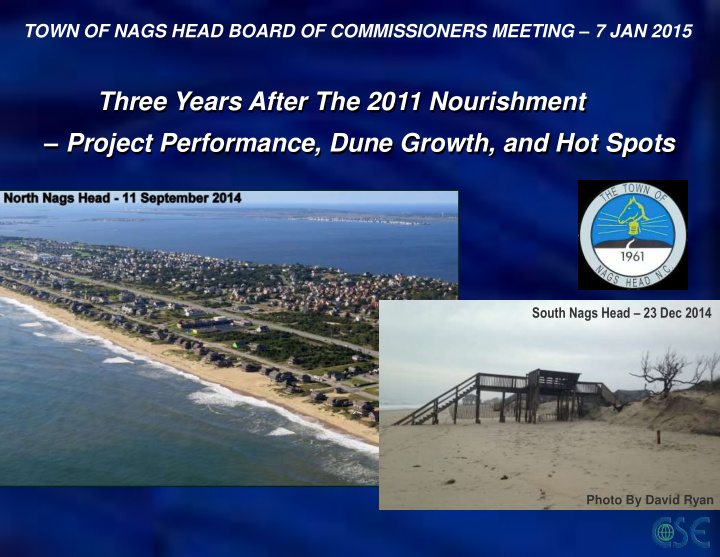



TOWN OF NAGS HEAD BOARD OF COMMISSIONERS MEETING – 7 JAN 2015 Three Years After The 2011 Nourishment – Project Performance, Dune Growth, and Hot Spots South Nags Head – 23 Dec 2014 Photo By David Ryan
2011 Nourishment The largest locally funded beach nourishment accomplished to date in the United States. • 4.6 million cubic yards • Along 10 miles • Over 100 borings to discover pristine sand source offshore • Project budget of $37 million • Unit Price – $6.56 per cubic yard • 5 years of environmental reviews • 5 months of summer construction between 24 May and 27 Oct 2011
Project Performance – Volume Changes 4.6 MCY Dune Growth
Project Performance – Volume Changes by Reach NH R1&2 – 8 mi >10% Gain South NH – 2 mi ~30% loss
Project Performance – Summary @ 3 years • Sediment Compaction Results o No different than native beaches o No tilling required • Nourishment Sand Remaining o Over 1 million cy more sand between dune and dry beach o 96% sand remaining to -19 ft NAVD (FEMA Offshore Limit) o North 8-mi of NH gained ~10%, south lost ~30% • Upcoast and Downcoast Changes o Upcoast gained ~230,000 cy to -19 ft NAVD o Downcoast gained ~170,000 cy to -19 ft NAVD • Biological Studies • CZR Study confirmed rapid recovery of organisms and no significant differences between project areas and unnourished areas “Wildlife thrives after Nags Head beach replenishment” Source: Virginian-Pilot (23 Jun2014)
Dune Management Plan – Beach Width 132.1 89.4 82.6 68.2 66.7 73.5 85.6 102.7 65.0 60.5 62.9 One-mile average dry-beach width in June 2014 between the toe of dune and the edge of dry sand (between +10 and +5 ft NAVD). Reach 1: 60-68 ft Reach 2: 83-89 ft Reach 3: 85-132 ft Reach 4: 85 ft
Dune Management Plan – Category 1 Place sand fencing close to the stable vegetation line, and re-vegetate bare areas
Dune Management Plan – Category 2 If the berm is >75 ft wide, place sand fencing ~25 ft seaward of the structure and promote dune buildup via fencing and vegetation.
Dune Management Plan – Category 3 Fencing should not be installed on the seaward side unless there is >75 ft of dry-sand beach seaward of the structure.
E. Seagull Dr Erosion Hot Spots Sta 995+00 • Re-exposed sandbags • Dune erosion • Low-elevated beach 10333 S. Old Oregon Inlet Rd. on 23 Dec 2014 (By D Ryan) Sta 1012+00 27 Oct 2014 (By C Ogburn)
E. Tern Street Sta 1009+00 Reach 3/4 S. Nags Head on 27 Oct 2014 (By C Ogburn) E. McCall Ct Sta 1019+00 Reach 4 S. Nags Head on 31 Oct 2014 (By CSE)
Erosion Hot Spots – Causes • South Nags Head has higher historical erosion rate than north Nags Head • Project End-losses • Profile Adjustment • Rhythmic Shoreline • Migrating versus persistent hot spots Recommendations • Additional survey in Fall 2015 • Short-term solution (eg. sand scraping) • Long-term solution (periodic re- nourishment) – Start permitting! • Most cost-effective long-term solution (combine nourishment with sand retaining structure)
Recommend
More recommend